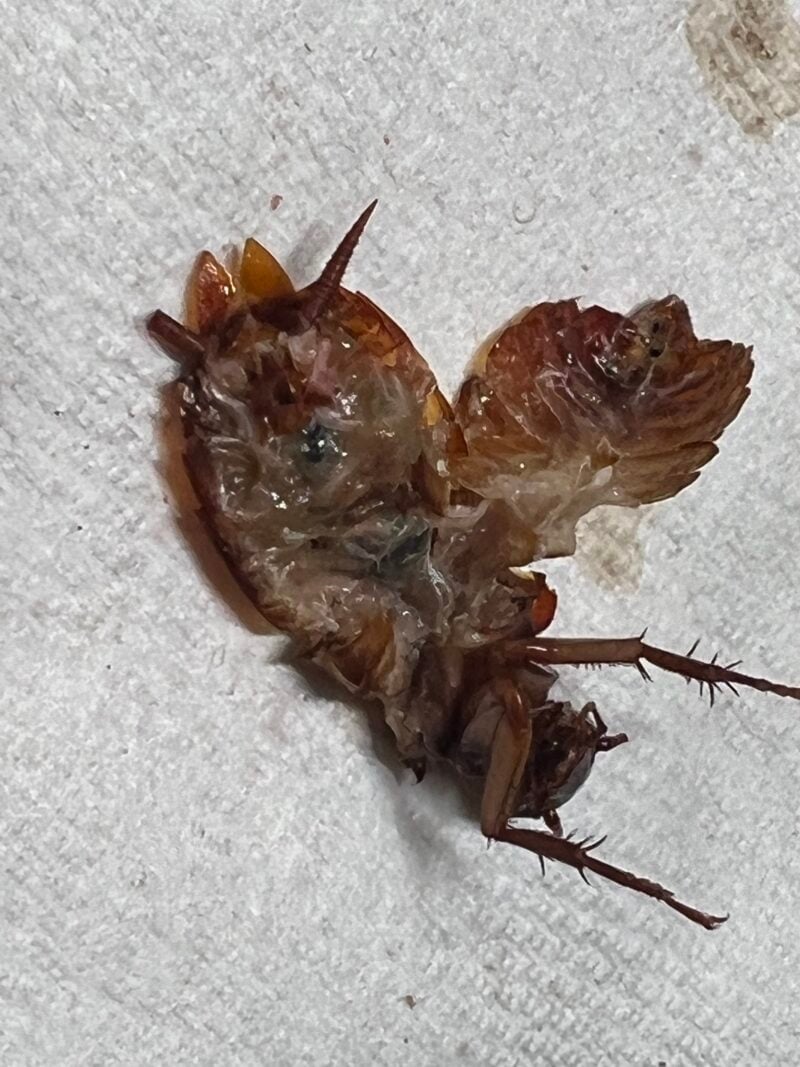
i dissected a roach by Anika H. '26
*cronch* *slurp*
content warning: discussions of roach uwu
Roaches are curious little creatures. They’ve nearly perfectly adapted to an urban environment, with a sturdy carapace, unparalleled scavenging prowess, and ability to fly. In other words, in a world that humans have built for themselves, the roach’s ability to thrive in all its squirming, leg-wiggling glory is terrifying.
On Tetazoo, we had a small streak where someone’s room seemed to become a roach spawn point for about a week. Most of them however, were either identified or caught by Harley. He’s consistently been the fastest sprinter down the hallway, and can probably spot a fly a building away. He’s got instincts akin to that of an experienced hunter. Harley is also the stinkiest little cat on hall and we love him.
Anyways, one time, when I found Harley batting away at a roach, I cupped its remains and took it away as usual. But to my surprise, because he tends to play with his food before he eats it, this particular roach was still mostly intact with the exception of half a leg and an antenna. I figured it would be a waste of a fresh corpse if I just threw it away, so against my best judgement, I decided to dissect it.

graphic details have been replaced with flowers for viewer discretion.
Now the rest of this post will contain detailed descriptions of our friendly neighborhood roach and her internal organs. It will be mildly gross, so viewer discretion is advised.
Basic Stats!
This is an American Cockroach (Periplaneta americana), a species of roach notorious for having a fast reproduction rate, spreading disease, being hard to kill, and being one of the most annoying household pests to get rid of. It’s currently in it’s nymph stage, since it hasn’t developed its wings yet and appears rather small for an adult (American cockroaches are the largest species of common roaches). You can also tell from the wider abdomen that this one is most likely a female. They live for 3 months to 2 years and females lay produce 150 young per year upon reaching adulthood.

almost-full roach, missing a few chunks of leg from the cat.
Setup
1 table
2 layers of cling wrap on top of the table
3 layers of paper towel on top of that to absorb liquid
Without a proper scalpel or other proper biology-related sharp things, I used an exacto knife, electronics tweezers, and (begrudgingly) the tiny scissors on my keychain multitool. I tried to get by with just the knife and the tweezers, but when I went to cut the exoskeleton with the knife, I nearly flung the roach across the table trying to cut sideways. Therefore for the safety of the wall, the intactness of the roach, and the preservation of my sanity, I had to sacrifice my one pair of small scissors.
Appendages
Before dissecting the rest of the roach, I removed the legs and antennae. Its feely bits and scuttlydoos got in the way of removing the carapace, so they were mostly cut, with the exception of one leg I thought I saw twitch a little bit. I wasn’t sure whether I imagined it or not, so I left it to see if it would react again. Their wigglers can take them up to 3 miles per hour, which is 50 body lengths per second, roughly equivalent to a human running 3 times as fast as a car on the highway.

roach leg under a microscope
Thorax
I first took off the small carapace covering the top of the thorax, revealing two lobes of flesh I initially thought were the lungs before quickly realizing that roaches didn’t have lungs. They were a set of thoracic muscles used to move the legs.

roach thoracic muscles
Abdomen and Digestive system
The abdomen was the most interesting part for me because it had the most stuff to unravel, metaphorically and literally. After removing the interstitial fat around the gut, I unrolled the intestines as carefully as I can with the tweezers. I still ended up accidentally poking a hole in the hind gut, causing a small blob of mostly-digested poop to spill out the side. The entire digestive system is around three times the length of the roach.
Head and– Nope
The rings on the exoskeleton around the neck would expand and contract when I tilted the head forward and back.

neck exoskeleton
Right before I started dissecting the head, I leaned in a bit too close and saw a blob of squishy white stuff in my hair.
It was roach guts.
I got roach guts in my hair.
I put everything down, washed my hands, and then chopped off that chunk of hair in the sink. This wasn’t quite the part where I stopped though. I went on to pry the compound eyes off the head, only getting bits at a time. Then I had a thought. Sometimes when I eat food or drink water, I would catch a bit of hair in my mouth. Even when I’m taking a test or something and straighten up from leaning over, the same thing tends to happen. At the image of eating a little bit of roach, I thought “I think I’ve had enough of this today.” and proceeded to pack up my stuff.

the joys of discovery
Clean up
I threw away the exacto blade I used and doused everything in way too much 90% isopropyl alcohol, removed my tools from the makeshift mat, and then wrapped everything to be discarded (roach and towels) in the cling wrap I had on the very bottom layer of the table, and chucked it in the trash. I wiped the table down as a last precaution.

Special thanks to my roommate Michelle for letting me do this in our room lol

